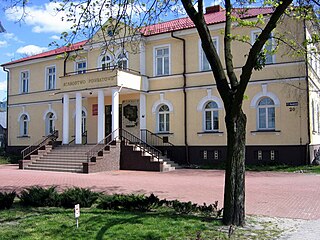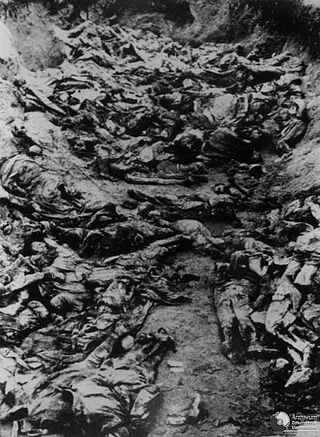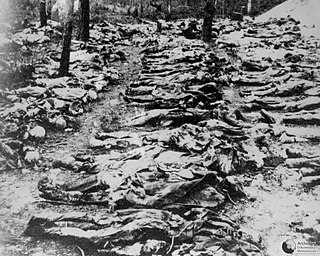Hungary

In 2008 there was a plaque erected at the Árpád Gimnázium, Grammar Schools wall at Budapest for commemorate the massacre.
Katyn massacre memorials commemorate the 1940 Katyn massacre by the Soviet NKVD.
Outside the Dom Polski Centre in Adelaide, Australia, there exists a monument to commemorate both the victims of the Katyn massacre and the Polish soliders killed in WWII. [1]
In front of Gardekirche in Vienna, Austria, there is a monument both to Katyn and Smolensk Polish tragedies. [2]
In Canada, a large metal sculpture has been erected in the Polish community of Roncesvalles in Toronto, to commemorate the killings. [3] The monument is found at Beaty Boulevard Parkette.

In 2008 there was a plaque erected at the Árpád Gimnázium, Grammar Schools wall at Budapest for commemorate the massacre.

Many cities in Poland now have memorials to the massacre in public spaces as well as within churches and cemeteries. For example, in Wrocław, a composition by Polish sculptor Tadeusz Tchórzewski is dedicated to the Katyn victims. Unveiled in 2000, it is in a park east of the city's centre, near the Racławice Panorama building. It shows the 'Matron of the Homeland' despairing over a dead soldier, while on a higher plinth the angel of death looms over, leaning forward on a sword. [4] There is also the Katyn-Kharkiv-Mednoye memorial in Świętokrzyskie Mountains, Poland . [5]
In South Africa, a memorial in Johannesburg commemorates the victims of Katyn, as well as South African and Polish airmen who flew missions from southern Italy to Poland to drop supplies over Warsaw during the Warsaw Uprising. [11]
In Ukraine, a memorial complex was erected to honor the over 4300 officer victims of the Katyń massacre killed in Pyatykhatky, 14 kilometres/8.7 miles north of Kharkiv in Ukraine; the complex lies in a corner of a former resort home for NKVD officers. Children had discovered hundreds of Polish officer buttons whilst playing on the site. [12]
There are several Katyn memorials in the UK, the best known of which was unveiled on 18 September 1976 at Gunnersbury Cemetery in London, amid considerable controversy. [13] [14] During the period of the Cold War, successive British governments objected to plans by the UK's Polish community to build a major monument to commemorate the massacre. [13] [15] [16] The Soviet Union did not want Katyn to be remembered, and put pressure on Britain to prevent the creation of the monument. [13] [17] As a result, the construction of the monument was delayed for many years. [15] [16] After the local community had finally secured the right to build the monument, no official government representative was present at the opening ceremony (although some politicians did attend the event unofficially). [13] [15] [16]
Another memorial in the UK was erected three years later, in 1979, in Cannock Chase, Staffordshire. [18] A memorial tablet by Ronald Sims has also been installed in the Airmen's Chapel within Southwell Minster in Nottinghamshire (there is a large Polish community in the county and each year a service is held to remember the massacre). In 1985, a memorial by Alexander Klecki was erected at Clifton Cathedral by the Polish community in Bristol. [19] There is also a Katyn memorial in Manchester's Southern Cemetery, unveiled in 1990, on one of the first occasions the British Government publicly acknowledged Katyn was a Soviet, rather than Nazi, war atrocity. [20]

A memorial is an object or place which serves as a focus for the memory or the commemoration of something, usually an influential, deceased person or a historical, tragic event. Popular forms of memorials include landmark objects such as homes or other sites, or works of art such as sculptures, statues, fountains or parks. Larger memorials may be known as monuments.

Żoliborz is one of the northern districts of the city of Warsaw. It is located directly to the north of the City Centre, on the left bank of the Vistula river. It has approximately 50,000 inhabitants and is one of the smallest boroughs of Warsaw. Despite its small size, the district has many green areas and mostly consists of low-rise architecture. Historically an upscale neighborhood and home to Warsaw's intelligentsia prior to World War II, Żoliborz is the second most expensive residential district in Warsaw after Śródmieście.

Słupca is a town in Greater Poland Voivodeship, central Poland, and the seat of Słupca County. It has 13,773 inhabitants (2018).

Katyn war cemetery is a Polish military cemetery located in Katyn, a small village 22 kilometres away from Smolensk, Russia, on the road to Vitebsk. It contains the remnants of 4,412 Polish officers of the Kozelsk prisoner of war camp, who were murdered in 1940 in what is called the Katyn massacre. Except for bodies of two Polish generals exhumed by German authorities in 1943 and then buried separately, all Polish officers murdered in Katyn were buried in six large mass graves. There is also a Russian part of the cemetery, where some 6,500 victims of the Soviet Great Purges of the 1930s were buried by the NKVD. The cemetery was officially opened in 2000.
The Augustów roundup was a military operation against the Polish World War II anti-communist partisans and sympathizers following the Soviet takeover of Poland. The operation was undertaken by Soviet forces with the assistance of Polish communist units, and conducted from July 10 to July 25, 1945, in Suwałki and Augustów region of northern Polish People's Republic.

The Katyn massacre was a series of mass executions of nearly 22,000 Polish military officers and intelligentsia prisoners of war carried out by the Soviet Union, specifically the NKVD in April and May 1940. Though the killings also occurred in the Kalinin and Kharkiv prisons and elsewhere, the massacre is named after the Katyn forest, where some of the mass graves were first discovered by German Nazi forces.
Katyn may refer to:

Katyń is a 2007 Polish historical drama film about the 1940 Katyn massacre, directed by Academy Honorary Award winner Andrzej Wajda. It is based on the book Post Mortem: The Story of Katyn by Andrzej Mularczyk. It was nominated for Best Foreign Language Film for the 80th Academy Awards.
There are memorials around the globe dedicated to the Azerbaijani victims of the Khojaly massacre — mostly civilians, but also armed troops — by local irregular Armenian forces and the 366th CIS regiment in the town of Khojaly on 26 February 1992.

The Katyń Memorial is a bronze statue created by Polish-American sculptor Andrzej Pitynski in dedication to the victims of Stalin's March 5 1940 Katyn massacre in which thousands of Polish Army officers and intellectual leaders who had been interned at Kozielsk or imprisoned at Ostashkov and Starobielsk had been killed by the occupying Soviet People's Commissariat for Internal Affairs, or NKVD. The memorial stands at Exchange Place in Jersey City, New Jersey, United States, near the mouth of the Hudson River. Unveiled in June 1991, the statue depicts a bound and gagged Polish soldier with a bayoneted rifle impaled through his back. The statue stands 34-foot-tall (10-meter) and is atop a granite base containing Katyn soil. Its base also depicts a Polish woman carrying her starving child in memorial to the Polish citizens deported to Siberia that began shortly before the massacre.

Gunnersbury Cemetery, also known as Kensington or New Kensington Cemetery, is a cemetery opened in 1929. Although it is owned and managed by the Royal Borough of Kensington and Chelsea, it is geographically located within the London Borough of Hounslow, at 143 Gunnersbury Avenue in Acton.

Wrocław Dwarves or Wrocław Gnomes are small figurines that have appeared in the streets of Wrocław, Poland since 2005. The dwarves' numbers have grown to at least 400 and they are a major tourist attraction for the city, which is the third largest in Poland. Tourists often walk around the city with a map trying to find all of them.

The National Katyń Memorial is a monument in Baltimore, Maryland, which memorializes the victims of the 1940 Katyn massacre of Polish nationals carried out by Soviet forces. Baltimore's Polish-American community was instrumental in having the monument built. The monument was unveiled in 2000 and is the tallest statue in Baltimore. The statue itself is 44 feet high, the whole monument, with base, is 56 feet.

Anti-Katyn is a denialism campaign intended to reduce and obscure the significance of the Katyn massacre of 1940 — where approximately 22,000 Polish officers were murdered by the Soviet NKVD on the orders of Joseph Stalin — by referencing the deaths from disease of thousands of Imperial Russian and Red Army soldiers at Polish internment camps during the Interwar period.

The following is a compilation of memorials to the composer Frédéric Chopin in the form of physical monuments, institutions, and other entities named after him.

The Monument to the Fallen and Murdered in the East is a monument in Warsaw, Poland which commemorates the victims of the Soviet invasion of Poland during World War II and subsequent repressions. It was unveiled on 17 September 1995, on the 56th anniversary of the Soviet invasion of 1939.
Gabriela Lucyna Zych was a Polish social activist who established the Katyn Families Association and became its leader. She was behind the creation of the city's monument in memory of victims of the 1940 Katyn massacre. Zych was a victim of the Smolensk air disaster in April 2010.

St Andrew Bobola Church, Hammersmith also known as the Polish Church in Shepherd's Bush is a Roman Catholic parish church serving the Polish community in West London. The building was designed in Gothic Revival style by Edmund Woodthorpe, and stands at 1 Leysfield Road, close to Ravenscourt Park.

The Jersey City 9/11 Memorial is located on the Hudson River Waterfront Walkway at the foot of Grand Street in Paulus Hook near Exchange Place in Jersey City, New Jersey. It comprises three components: a sculpture of steel girders from the original World Trade Center, an inscribed black granite stele, and Makeshift Memorial. The site on the Hudson Waterfront opposite the World Trade Center site was a triage set up during the '9/11 boatlift' and thereafter became a staging area for rescue operations.